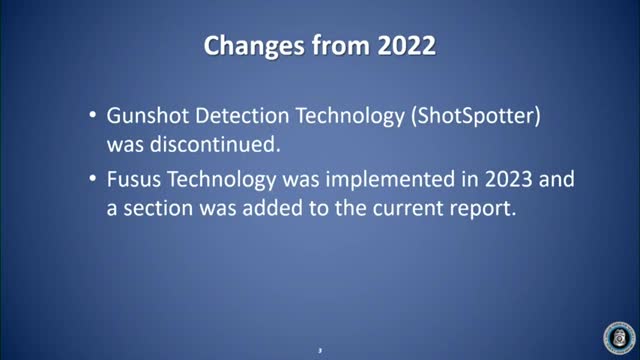Police unveil advanced tech to combat crime in Dayton
July 18, 2024 | Dayton City Council, Dayton, Montgomery County, Ohio

This article was created by AI summarizing key points discussed. AI makes mistakes, so for full details and context, please refer to the video of the full meeting. Please report any errors so we can fix them. Report an error »

In a recent government meeting, officials discussed the discontinuation of the ShotSpotter gunshot detection technology, which was phased out in 2023. The decision was attributed to financial constraints and staffing challenges, despite the technology's effectiveness. Officials indicated that they may reconsider gunshot detection technology in the future.
The meeting also highlighted the implementation of a new technology called FUSIS, which combines multiple systems and was part of a successful trial initiated by the Ohio Attorney General's office. This technology aims to enhance public safety, particularly in downtown Dayton, where public safety cameras have been upgraded after 13 years of use. The improvements have reportedly led to a positive impact on crime response and community safety.
Additionally, the use of body-worn cameras has been emphasized, with over 400 units currently in operation. These cameras are crucial for documenting police interactions and providing evidence for criminal cases. The department has maintained strict auditing and usage policies, issuing training memos and reprimands when necessary.
Motor vehicle recorders (MVRs) were also discussed, which work in conjunction with body-worn cameras to enhance documentation of traffic offenses and monitor subject transports. The cost for the Fleet 3 system, which includes license plate readers, was noted to be $343,000.
License plate readers, specifically the Flock Safety system, were highlighted for their role in automating the scanning of license plates and alerting officers to vehicles involved in crimes. The technology has proven effective in several recent incidents, including arrests related to homicide, assault, and robbery. Officials reported multiple success stories, showcasing the system's ability to aid law enforcement in real-time.
Overall, the meeting underscored the ongoing efforts to leverage technology in public safety while addressing budgetary and staffing limitations.
The meeting also highlighted the implementation of a new technology called FUSIS, which combines multiple systems and was part of a successful trial initiated by the Ohio Attorney General's office. This technology aims to enhance public safety, particularly in downtown Dayton, where public safety cameras have been upgraded after 13 years of use. The improvements have reportedly led to a positive impact on crime response and community safety.
Additionally, the use of body-worn cameras has been emphasized, with over 400 units currently in operation. These cameras are crucial for documenting police interactions and providing evidence for criminal cases. The department has maintained strict auditing and usage policies, issuing training memos and reprimands when necessary.
Motor vehicle recorders (MVRs) were also discussed, which work in conjunction with body-worn cameras to enhance documentation of traffic offenses and monitor subject transports. The cost for the Fleet 3 system, which includes license plate readers, was noted to be $343,000.
License plate readers, specifically the Flock Safety system, were highlighted for their role in automating the scanning of license plates and alerting officers to vehicles involved in crimes. The technology has proven effective in several recent incidents, including arrests related to homicide, assault, and robbery. Officials reported multiple success stories, showcasing the system's ability to aid law enforcement in real-time.
Overall, the meeting underscored the ongoing efforts to leverage technology in public safety while addressing budgetary and staffing limitations.
View full meeting
This article is based on a recent meeting—watch the full video and explore the complete transcript for deeper insights into the discussion.
View full meeting
